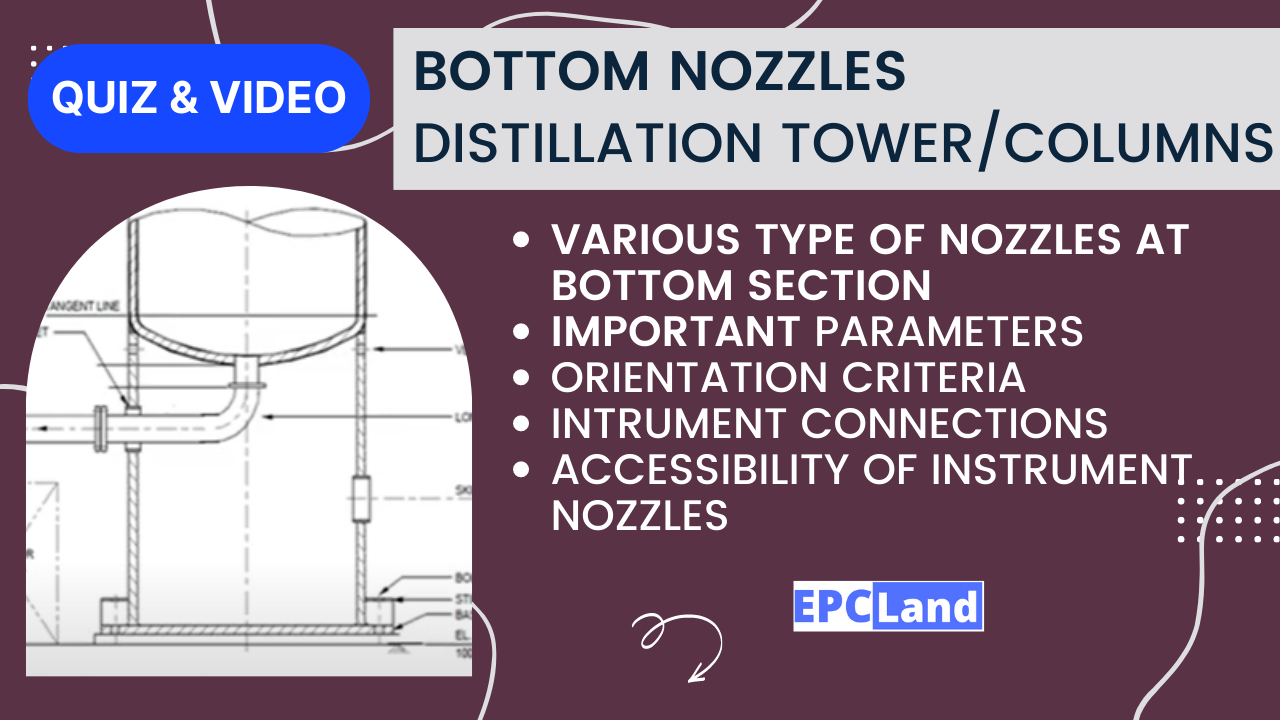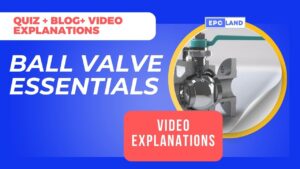Nozzles at the bottom section of a distillation tower is a critical component that requires careful design and consideration. One of the key aspects of this section is the arrangement of nozzles, which serve as connection points for instruments, equipment, and pipes. In this comprehensive guide, we’ll explore the different types of nozzles found at the bottom section of distillation towers, the important parameters to consider during their placement, orientation criteria, instrument connections, and the accessibility of these connections.
Table of Contents
Don’t miss the Complete Course on Piping Engineering: Check Now
By EPCLand.com
Important Parameters for Nozzle Placement
When it comes to designing the bottom section of a distillation tower, several parameters play a crucial role in determining the placement of nozzles. These parameters include:
- Process Requirements: The specific processes taking place within the distillation tower influence the types and sizes of nozzles needed. Different processes might require different instruments or equipment connections, affecting the arrangement of nozzles.
- Equipment Arrangement: The layout of equipment, such as reboilers, pumps, and heat exchangers, impacts the location of nozzles. The proximity of equipment to the bottom section can determine the optimal positions for nozzle placements.
- Piping and Flow Considerations: The flow of liquids and gases within the tower should be carefully analyzed. Nozzle placement should take into account the flow patterns to avoid interference and ensure efficient operations.
Orientation Criteria for Bottom Nozzles
The orientation of bottom nozzles is a crucial factor that affects the functionality and safety of the distillation tower. The following criteria should be considered during the orientation process:
- Gravity Separation: Nozzles should be oriented to allow proper gravity separation of different phases within the tower. This ensures that liquids and gases are appropriately separated for efficient distillation processes.
- Vapor Disengagement: Adequate space must be provided above liquid-level nozzles to allow for vapor disengagement. Improper orientation can lead to vapor entrainment, affecting the tower’s overall performance.
- Accessibility: Nozzles should be positioned for easy access during maintenance and inspection activities. Proper orientation ensures that instruments and equipment connected to these nozzles can be reached without difficulty.
Instrument Connections for Bottom Nozzles
Instrument connections play a pivotal role in monitoring and controlling the distillation process. Some common instrument connections found at the bottom section of distillation towers include:
- Temperature Sensors: Temperature sensors are crucial for monitoring heat exchange and distillation efficiency. Placing these sensors at strategic points within the bottom section provides accurate temperature readings.
- Pressure Transmitters: Pressure transmitters help maintain safe operating conditions. They are often connected to nozzles to measure pressure variations and ensure the tower’s stability.
- Level Indicators: Level indicators are essential for monitoring liquid levels within the tower. Properly positioned level indicator connections offer real-time insights into the distillation process.
Accessibility of Instrument Connections
Ensuring easy accessibility to instrument connections is essential for efficient maintenance and troubleshooting. Proper access points make it possible to install, calibrate, and replace instruments without disrupting the entire distillation process. To ensure accessibility:
- Consider Platform Placement: Design platforms, walkways, or ladders around the bottom section to facilitate easy access to instrument connections. Adequate spacing and clear pathways can simplify maintenance tasks.
- Group Instruments: Cluster related instruments together to minimize the need for extensive movement during maintenance. This approach streamlines the process and reduces downtime.
- Provide Clear Labeling: Label instrument connections clearly to prevent confusion and expedite maintenance activities. Proper labeling ensures that technicians can quickly identify and address specific instruments.
FAQs
Q1: What are the different types of nozzles at the bottom section of a distillation tower? A1: The types of nozzles include liquid-level nozzles, vapor inlet nozzles, instrument connections, and drain nozzles.
Q2: Why is nozzle orientation important in the bottom section of a distillation tower? A2: Proper nozzle orientation ensures efficient gravity separation, prevents vapor entrainment, and facilitates easy maintenance access.
Q3: How do instrument connections contribute to distillation tower operation? A3: Instrument connections provide real-time data on temperature, pressure, and liquid levels, helping monitor and control the distillation process.
Q4: What is the significance of accessibility in instrument connections? A4: Easy accessibility simplifies maintenance, calibration, and replacement of instruments, reducing downtime and enhancing operational efficiency.
Q5: How can I ensure proper orientation and accessibility of bottom nozzles on a distillation tower? A5: By considering process requirements, equipment layout, flow patterns, and safety regulations, you can determine optimal nozzle placement. Additionally, designing platforms and walkways for easy access and providing clear labeling can enhance accessibility.
In conclusion, the arrangement of various types of nozzles at the bottom section of a distillation tower is a critical aspect of tower design. By carefully considering important parameters, orientation criteria, instrument connections, and accessibility, engineers can ensure the optimal functionality, safety, and maintainability of distillation towers. Proper nozzle placement and orientation contribute to efficient separation processes and accurate monitoring, while accessible instrument connections facilitate smooth maintenance and troubleshooting operations.
Recommended courses (Published on EPCLand)
- Basics of Piping Engineering
- Piping Layout Engineering
- Piping Material Engineering
- Piping Stress Analysis
- Complete Course on Piping Engineering
- Material Requisitions
- Piping Material Specifications
- Valve Material Specifications
Don’t miss the published articles on following:
Related Video
Attempt Quiz
Question 1:
What are the various types of nozzles typically found at the bottom section of distillation towers?
Explanation: The various types of nozzles commonly found at the bottom section of distillation towers include Feed Nozzle, Product Nozzle, and Reflux Nozzle.
Question 2:
Which of the following is an important parameter to consider for bottom nozzle design?
Explanation: Process temperature and pressure are important parameters to consider for the design of bottom nozzles on distillation towers, ensuring the structural integrity and safe operation of the equipment.
Question 3:
What is an important orientation criterion for bottom nozzles of distillation towers/columns?
Explanation: An important orientation criterion for bottom nozzles of distillation towers/columns is the nozzle orientation relative to the vessel shell, ensuring proper installation and performance.
Question 4:
What is the purpose of instrument connections on bottom nozzles of distillation towers/columns?
Explanation: Instrument connections on bottom nozzles of distillation towers/columns serve the purpose of facilitating maintenance and monitoring of the process conditions within the tower.
Question 5:
What is the significance of accessibility of instrument connections on distillation towers?
Explanation: The accessibility of instrument connections on distillation towers is significant because it enables ease of maintenance, calibration, and monitoring of process parameters, ensuring efficient and safe tower operation.



